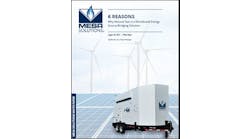Preparing for Emergencies with Wind, Solar, Energy Storage and Microgrids
John Shenot, of the Regulatory Assistance Project, explains why wind, solar, energy storage and microgrids are becoming attractive to planners focused on resilience.
Resilience is a character trait that is universally admired and respected in people. In recent years, it has also gained attention as a new imperative for infrastructure planning and development. In the wake of Superstorm Sandy and other recent natural disasters, there is heightened awareness that one of the essential components of resilience is the need to keep critical facilities—those needed for medical, public safety, and national defense reasons—operating during prolonged grid outages.
Communities have long relied on diesel-fueled backup generators to maintain power during outages. But these generators can be an expensive solution to an infrequent problem, they require the delivery and storage of enough liquid fuel to get through an outage, and they can emit extremely high levels of particulate matter and other pollutants. These generators tend to serve us well when the grid goes down temporarily, but are less effective when a major emergency knocks the grid out for days—or longer.
Today, advances in distributed energy resources are expanding the options for backup and emergency power. In particular, the capabilities and costs of renewable distributed generation (DG) technologies (primarily wind turbines and solar photovoltaic panels), combined with electricity storage and microgrid enabling technologies, are becoming quite attractive to planners focused on resilience. These technologies can potentially be more flexible and less expensive than traditional diesel backup solutions.
On the final day of the February meetings of the National Association of Regulatory Utility Commissioners (NARUC), this emerging trend was on full display. Speakers from the U.S. Air Force, Army, and Navy gave superb presentations on how they are boosting resilience by installing renewable distributed generation with storage and microgrid capabilities on military installations. These systems are designed to operate as isolated microgrids and provide enough power to serve all critical loads on their respective bases for an indefinite period of time during emergencies. But unlike diesel generators, the renewable distributed generation systems are grid-connected and provide energy, capacity, and ancillary services to the broader utility system during routine (non-emergency) conditions. This provides revenue streams and third-party financing options that diesel backup generators simply cannot match, so much so that the systems have virtually no impact on the Defense Department’s capital budget.
Local governments are also catching on. Like military installations, local governments need to maintain power to serve critical loads (e.g., police and fire stations, emergency shelters, water, and wastewater treatment plants) during extended emergencies. Some excellent examples of planning for resilience can be found among the projects funded by the U.S. Department of Energy’s Solar Market Pathways program, including:
- The San Francisco Department of the Environment is leading a Solar and Energy Storage for Resiliency project to bolster emergency preparedness in the city. As part of this project, they have already reviewed their existing emergency response plans, mapped critical facilities within the city, identified the critical loads for five types of buildings, and built a tool for determining the size of a solar-plus-storage system that can meet those critical loads. Many of their tools and methods could be replicated in other cities. Still to come for this project is the actual procurement and installation of several resilient solar-plus-storage systems.
- The City University of New York (CUNY) leads a Smart DG Hub: Resilient Solar project and is creating a “roadmap” for resilient solar in New York City that can be replicated across the state and the rest of the country. In the aftermath of Superstorm Sandy, there were more than 600 solar arrays in the city that were unable to provide power because they weren’t designed or constructed for emergency operation. To better prepare for the next emergency, CUNY has produced a variety of fact sheets on resilient solar hardware and economics, hosted public workshops, and added a solar-plus-storage layer to the statewide NY Solar Map. CUNY has also developed a relatively simple spreadsheet model (with detailed documentation) for financial analysis of resilient solar-plus-storage systems. The team is currently working with the National Renewable Energy Laboratory to develop reasonable ways to estimate the economic value of resilience.
The Institute for Sustainable Communities, with whom RAP works to support and provide technical assistance to Solar Market Pathways project teams, is hosting a free interactive workshop entitled “Solar + Battery Storage to Support Community Resilience” on May 8 in St. Paul, Minnesota. Municipal and regional officials, planners, nonprofit leaders, and citizens who want to learn how to implement solar and battery storage across their community are invited to attend. The workshop will feature best practices, tools, and resources for resilient solar that are now available to communities interested in solar and battery storage. The workshop is timed to coincide with the National Adaptation Forum, which begins the following day at the same venue and will bring together hundreds of practitioners working across the country to prepare communities for a changing climate.
Clearly, the push is on to make our critical infrastructure more resilient. New and improved technologies are expanding the options for meeting that need, and technology costs are coming down, but the number of working examples that do not involve diesel generators is still limited. Regulators and policymakers can support the use of distributed energy resources for enhanced resilience by putting in place smart rate designs, interconnection standards, and wholesale market rules that recognize the value of resilient and reliable electric service for critical needs during emergencies.
John Shenot is a senior associate at the Regulatory Assistance Project. He advises state utility commissions and environmental regulatory agencies throughout the United States on public policy best practices.






